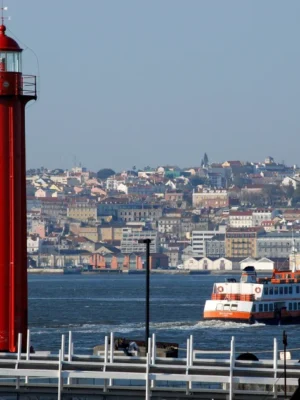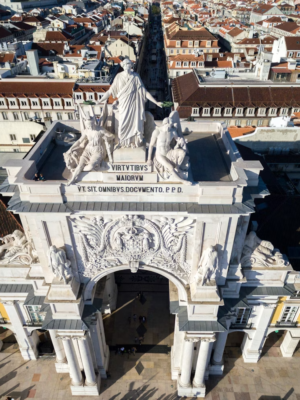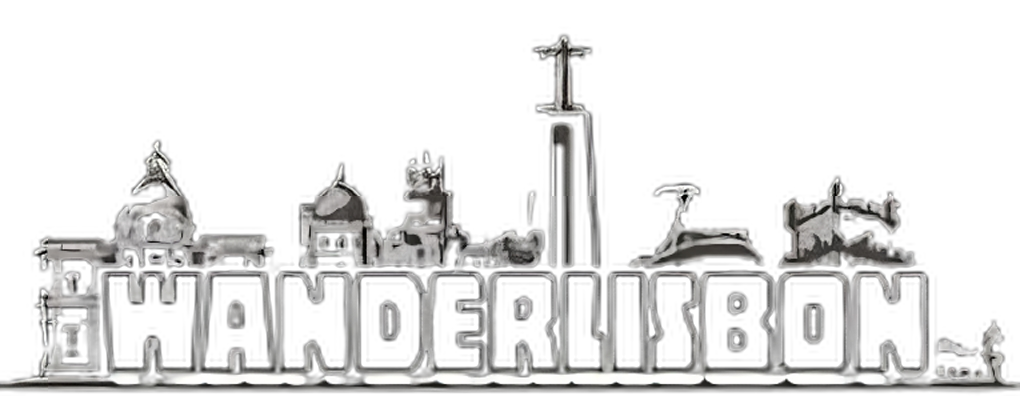Recommendations for restaurants near Torre de Belém with the highest ratings on Tripadvisor.
- La Paleta Belém: This restaurant is located at Jardim da Torre de Belém, 0.1 km from Belém Tower. It serves street food
- Cafe Do Forte: This restaurant is located at Avenida Brasilia Forte Do Bom Sucesso, 0.1 km from Belém Tower. It serves Bar, Cafe, and European cuisine
- Confeitaria Nacional Belém: This restaurant is located at Cais da Princesa à Torre de Belem – 1400-038 Lisboa Junto à Torre de Belém, 0.2 km from Belém Tower. It serves Portuguese and Cafe cuisine
- Vela Latina: This restaurant is located at Doca do Bom Sucesso, 0.3 km from Belém Tower. It serves Mediterranean, European, and Portuguese cuisine
- Nikkei: This restaurant is located at Doca do Bom Sucesso, 0.2 km from Belém Tower. It serves Peruvian, Sushi, Japanese, and Asian cuisine




Touch each icon to get the information.
How to get there
Detailed instructions to help a tourist get from Praça do Comércio to the Belém Tower and the Monument to the Discoveries by bus:
1. Leave Praça do Comércio and walk towards the center of the square.
2. Head to the bus stop located on the southwest corner of the square, near the Rua Augusta arch.
3. Once at the bus stop, look for bus number 728, which will take you directly to the Belém Tower and the Monument to the Discoveries.
4. Make sure you have enough cash or a valid transport card to pay for the bus ticket. You can purchase it at the ticket counters or vending machines available at the nearby metro station.
5. When bus number 728 arrives at the bus stop in Praça do Comércio, board the bus and remember to validate your ticket at the validation machine upon boarding.
6. Once inside the bus, pay attention to the announcements and the upcoming stops. If you have any questions, feel free to ask the driver or fellow passengers.
7. When you reach the “Torre de Belém” bus stop, alight from the bus and make your way towards the Belém Tower, which will be a short distance away. You will see an impressive structure in front of you.
8. To reach the Monument to the Discoveries from the Belém Tower, walk towards the banks of the Tagus River. On your left, you will find the monument just a few meters away. You won’t be able to miss it as it is a striking caravel-shaped structure.
9. Enjoy your visit to the Belém Tower and the Monument to the Discoveries.
Scenario 1: Starting from the Blue Line (Linha Azul)
1. If you are starting from a station on the Blue Line, take the metro towards Santa Apolónia.
2. Get off at the Terreiro do Paço station.
3. Once at Terreiro do Paço, follow the signs to the Green Line (Linha Verde).
4. Take the metro towards Cais do Sodré.
5. Get off at the Cais do Sodré station.
6. From Cais do Sodré, follow the signs to the train station located inside the metro station.
7. Take the train on the Cascais Line (Linha de Cascais) heading towards Cascais.
8. Get off at the Belém station.
9. Exit the train station and walk towards the river. You will find the Belém Tower and the Monument to the Discoveries nearby.
Scenario 2: Starting from the Green Line (Linha Verde)
1. If you are starting from a station on the Green Line, take the metro towards Cais do Sodré.
2. Get off at the Cais do Sodré station.
3. From Cais do Sodré, follow the signs to the train station located inside the metro station.
4. Take the train on the Cascais Line heading towards Cascais.
5. Get off at the Belém station.
6. Exit the train station and walk towards the river. You will find the Belém Tower and the Monument to the Discoveries nearby.
Scenario 3: Starting from the Yellow Line (Linha Amarela)
1. If you are starting from a station on the Yellow Line, take the metro towards Rato.
2. Get off at the Rato station.
3. From Rato, transfer to the Blue Line (Linha Azul) towards Santa Apolónia.
4. Get off at the Terreiro do Paço station.
5. Once at Terreiro do Paço, follow the signs to the Green Line (Linha Verde).
6. Take the metro towards Cais do Sodré.
7. Get off at the Cais do Sodré station.
8. From Cais do Sodré, follow the signs to the train station located inside the metro station.
9. Take the train on the Cascais Line heading towards Cascais.
10. Get off at the Belém station.
11. Exit the train station and walk towards the river. You will find the Belém Tower and the Monument to the Discoveries nearby.
Please note that the metro and train schedules may vary, so it’s always a good idea to check the latest timetables and plan your journey accordingly.

Above in the photo gallery you will find the map in real size.
Detailed instructions on how to get to the Belém Tower and the Monument to the Discoveries using the train from Cais do Sodré station. Additionally, I will include information on how to reach Cais do Sodré station from Praça do Comércio using bus number 728 or the metro on the Green Line.
To reach Cais do Sodré station from Praça do Comércio, you have two options:
Option 1: Bus number 728
1. Head to the bus stop located at Praça do Comércio.
2. Board bus number 728 heading to Cais do Sodré.
3. Stay on the bus until you reach Cais do Sodré station.
Option 2: Metro (Green Line)
1. Head to the nearest metro station from Praça do Comércio.
2. Board the metro on the Green Line (towards Cais do Sodré).
3. Stay on the metro until you reach Cais do Sodré station.
Once you have reached Cais do Sodré station, follow these instructions to get to the Belém Tower and the Monument to the Discoveries using the train:
1. At Cais do Sodré station, look for signs and directions leading you to the Cascais train line.
2. Board the train heading to Cascais.
3. Stay on the train until you reach Belém station.
4. Upon arrival at Belém station, follow the signs and walk towards the Belém Tower or the Monument to the Discoveries. Both points of interest are just a few meters away from each other.
Remember to check the train schedules and have a valid ticket before boarding. If you have any questions during the journey, feel free to ask station staff for further information and confirmation of directions.
To get to Cais do Sodré station from Praça do Comércio, you have several additional options besides the bus and metro. If you are near Praça do Comércio, you can choose to walk to Cais do Sodré station as it is at a manageable distance.
You can also rent an electric scooter or a bicycle through various companies that offer these services in Lisbon through an app. Some of the most popular companies are:
1. Lime
2. VOI
3. Hive
4. Bungo
5. Tier
6. Jump
These companies offer electric scooters and bicycles for rent in the city. You can download the corresponding app for each company to see the locations of available scooters and bikes.
The distance between Praça do Comércio and Cais do Sodré station is approximately 1.5 kilometers. To get to the station from Praça do Comércio, you can follow Rua da Alfândega, which will take you directly to the station. As you walk along this street, you will come across some relevant sites such as:
1. Design and Fashion Museum (Museu do Design e da Moda)
2. Ribeira Market (Time Out Market Lisboa)
3. Santa Catarina Church
4. Ajuda National Palace
These places can be additional points of interest to visit on your way to Cais do Sodré station. Remember to respect traffic regulations and follow traffic signs if you choose to walk, use an electric scooter, or bicycle.
Once you arrive at the site, listen to a brief explanation of the history of the place.
- Audio in English
- Audio en français
- Audio en Español
- Audio auf Deutsch





Choose Your Language.
- Reading in English
- Lire en Français
- Lectura en Español
- Lesen auf Deutsch
The Tower of Belém, also known as the Tower of St. Vincent, is a 16th-century architectural gem strategically located on the banks of the River Tagus. It was built between 1514 and 1520, during the era of Portuguese discoveries, to protect the city and control the entrance to the port of Lisbon.
The tower was designed by the architect Francisco de Arruda in a unique style called Manueline, which blends Gothic, Renaissance, and maritime elements. If you observe its façade closely, you will notice a rich ornamentation representing maritime motifs, such as ropes, seashells, and armillary spheres, symbols that evoke the adventurous and seafaring spirit of the time.
Throughout the centuries, the Tower of Belém has played several important roles. During its early existence, it served as a defensive fortress to protect the city from enemy attacks. It also had customs duties functions, as it was used to collect taxes from ships arriving in Lisbon.
One of the most notable stories of the Tower of Belém is its role as a starting point for numerous maritime expeditions that explored new routes and discovered unknown lands during the Age of Discoveries. It was from here that famous Portuguese navigators, such as Vasco da Gama, set sail in search of new lands and wealth in Africa, Asia, and America.
Over the centuries, the Tower of Belém has suffered damages and undergone restorations, but it has managed to preserve its essence and historical significance. In 1983, it was declared a UNESCO World Heritage site, recognizing its value as a testimony to the greatness and vision of Portuguese explorers.
Now, I invite you to explore this magnificent structure. Inside the tower, you will find different levels, including the Governor’s Hall, the Hall of Kings, and the Terrace Balcony, from where you can enjoy breathtaking panoramic views of Lisbon and the River Tagus.
La Tour de Belém, également connue sous le nom de Tour de Saint-Vincent, est un joyau architectural du XVIe siècle stratégiquement situé sur les rives du fleuve Tage. Elle a été construite entre 1514 et 1520, pendant l’époque des découvertes portugaises, pour protéger la ville et contrôler l’entrée du port de Lisbonne.
La tour a été conçue par l’architecte Francisco de Arruda dans un style unique appelé manuélin, qui mélange des éléments gothiques, Renaissance et marins. Si vous observez attentivement sa façade, vous remarquerez une riche ornementation représentant des motifs marins tels que des cordes, des coquillages et des sphères armillaires, des symboles qui évoquent l’esprit d’aventure et de navigation de l’époque.
Au fil des siècles, la Tour de Belém a joué plusieurs rôles importants. Pendant ses premières années, elle a servi de forteresse défensive pour protéger la ville des attaques ennemies. Elle avait également des fonctions douanières, car elle était utilisée pour collecter les taxes des navires arrivant à Lisbonne.
L’une des histoires les plus remarquables de la Tour de Belém est son rôle de point de départ de nombreuses expéditions maritimes qui ont exploré de nouvelles routes et découvert des terres inconnues pendant l’ère des découvertes. C’est d’ici que de célèbres navigateurs portugais, tels que Vasco de Gama, ont pris la mer à la recherche de nouvelles terres et de richesses en Afrique, en Asie et en Amérique.
Au fil des siècles, la Tour de Belém a subi des dommages et des restaurations, mais elle a réussi à préserver son essence et sa signification historique. En 1983, elle a été déclarée site du patrimoine mondial de l’UNESCO, reconnaissant sa valeur en tant que témoignage de la grandeur et de la vision des explorateurs portugais.
Maintenant, je vous invite à explorer cette magnifique structure. À l’intérieur de la tour, vous trouverez différents niveaux, dont la salle du gouverneur, la salle des rois et le balcon de la terrasse, d’où vous pourrez profiter de vues panoramiques à couper le souffle sur Lisbonne et le fleuve Tage.
La Torre de Belém, también conocida como la Torre de San Vicente, es una joya arquitectónica del siglo XVI que se encuentra estratégicamente ubicada a orillas del río Tajo. Fue construida entre los años 1514 y 1520, durante la época de los descubrimientos portugueses, para proteger la ciudad y controlar la entrada al puerto de Lisboa.
La torre fue diseñada por el arquitecto Francisco de Arruda en un estilo único llamado manuelino, que fusiona elementos góticos, renacentistas y marineros. Si observan detenidamente su fachada, notarán una rica ornamentación que representa motivos marinos, como cuerdas, caracolas y esferas armilares, símbolos que evocan el espíritu aventurero y marinero de la época.
A lo largo de los siglos, la Torre de Belém ha desempeñado varios roles importantes. Durante los primeros años de su existencia, sirvió como fortaleza defensiva para proteger a la ciudad de los ataques enemigos. Pero también tuvo funciones aduaneras, ya que se utilizaba para recaudar impuestos de los barcos que llegaban a Lisboa.
Una de las historias más destacadas de la Torre de Belém es su papel como punto de partida para numerosas expediciones marítimas que exploraron nuevas rutas y descubrieron tierras desconocidas durante la Era de los Descubrimientos. Fue desde aquí que navegantes portugueses famosos, como Vasco de Gama, partieron en busca de nuevas tierras y riquezas en África, Asia y América.
A lo largo de los siglos, la Torre de Belém ha sufrido daños y restauraciones, pero ha logrado mantener su esencia y su importancia histórica. En 1983, fue declarada Patrimonio de la Humanidad por la UNESCO, reconociendo su valor como testimonio de la grandeza y la visión de los exploradores portugueses.
Ahora, les invito a que exploren esta magnífica estructura. Dentro de la torre encontrarán diferentes niveles, incluyendo la Sala del Gobernador, la Sala de los Reyes y el Balcón de la Terraza, desde donde podrán disfrutar de impresionantes vistas panorámicas de Lisboa y el río Tajo.
Willkommen im Turm von Belém in Lissabon! Ich bin Ihr Reiseführer und heute werde ich Ihnen die faszinierende Geschichte dieses ikonischen Monuments erzählen.
Der Turm von Belém, auch bekannt als Turm des Heiligen Vinzenz, ist ein architektonisches Juwel aus dem 16. Jahrhundert, das strategisch am Ufer des Flusses Tejo liegt. Er wurde zwischen 1514 und 1520 während der Zeit der portugiesischen Entdeckungen erbaut, um die Stadt zu schützen und den Zugang zum Hafen von Lissabon zu kontrollieren.
Der Turm wurde vom Architekten Francisco de Arruda in einem einzigartigen Stil namens Manuelin entworfen, der gotische, Renaissance- und maritime Elemente verbindet. Wenn Sie die Fassade genau betrachten, werden Sie eine reiche Verzierung mit maritimen Motiven wie Seilen, Muscheln und Armillarsphären bemerken, Symbole, die den abenteuerlichen und seefahrenden Geist jener Zeit hervorrufen.
Im Laufe der Jahrhunderte hat der Turm von Belém mehrere wichtige Funktionen erfüllt. In seinen frühen Jahren diente er als Verteidigungsfort, um die Stadt vor Feindesangriffen zu schützen. Er hatte auch zollrechtliche Aufgaben, da er dazu genutzt wurde, Steuern von den in Lissabon ankommenden Schiffen einzunehmen.
Eine der bemerkenswertesten Geschichten des Turms von Belém ist seine Rolle als Ausgangspunkt für zahlreiche Seefahrts-Expeditionen, die während des Zeitalters der Entdeckungen neue Routen erforschten und unbekannte Länder entdeckten. Von hier aus starteten berühmte portugiesische Seefahrer wie Vasco da Gama auf der Suche nach neuen Ländern und Reichtümern in Afrika, Asien und Amerika.
Im Laufe der Jahrhunderte hat der Turm von Belém Schäden erlitten und Restaurierungen durchlaufen, aber es ist ihm gelungen, seine Essenz und historische Bedeutung zu bewahren. Im Jahr 1983 wurde er von der UNESCO zum Weltkulturerbe erklärt, was seinen Wert als Zeugnis für die Größe und Vision der portugiesischen Entdecker anerkennt.
Nun lade ich Sie ein, diese prächtige Struktur zu erkunden. Im Inneren des Turms finden Sie verschiedene Ebenen, darunter den Saal des Gouverneurs, den Saal der Könige und den Terrassenbalkon, von dem aus Sie atemberaubende Panoramablicke auf Lissabon und den Tejo-Fluss genießen können.
Closest Nearby Destination: Discover the Next Stop from Here
Monument To The Discoveries: Celebrating Portugal’s Age Of Exploration And Adventure
Related products
-

Unveiling Cacilhas: Exploring the Enchanting Side of Lisbon’s Coastline.
-

Jerónimos Monastery: Exploring Lisbon’s Majestic UNESCO Heritage Site and Spiritual Haven
- Lisboa, Architecture, Historic Sites, Historical Monuments, Landmarks, Museums and Art Galleries, Places
-

Arco de Rua Augusta (Rua Augusta Arch) – Lisbon’s Triumphal Arch
-

Unveiling the Splendor of the Moorish Castle: Discovering Sintra’s Historic Gem.
- Lisboa, Architecture, Castles, Gardens and Parks, Historic Sites, Historical Monuments, Landmarks, Places, Viewpoints







Reviews
There are no reviews yet.